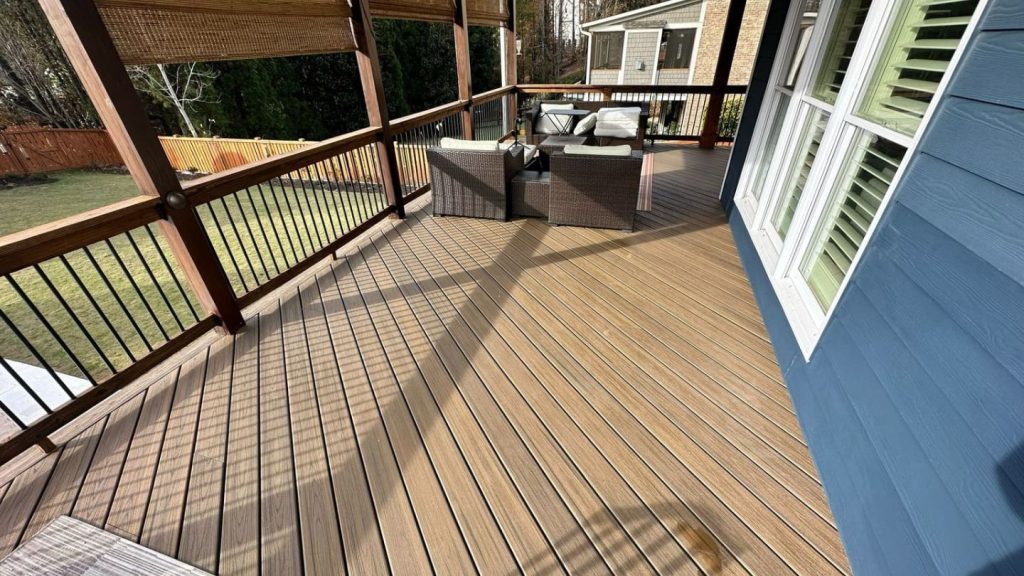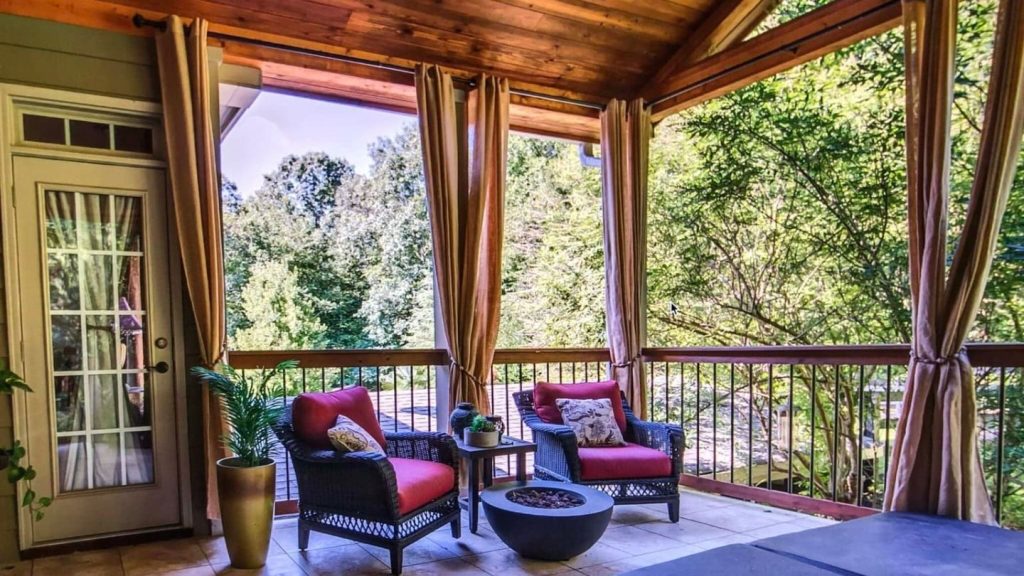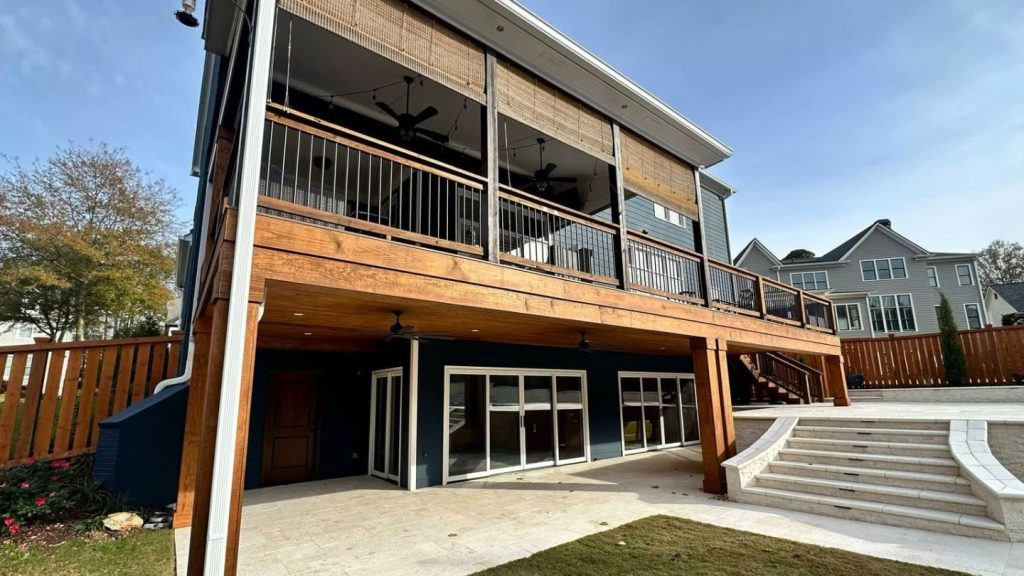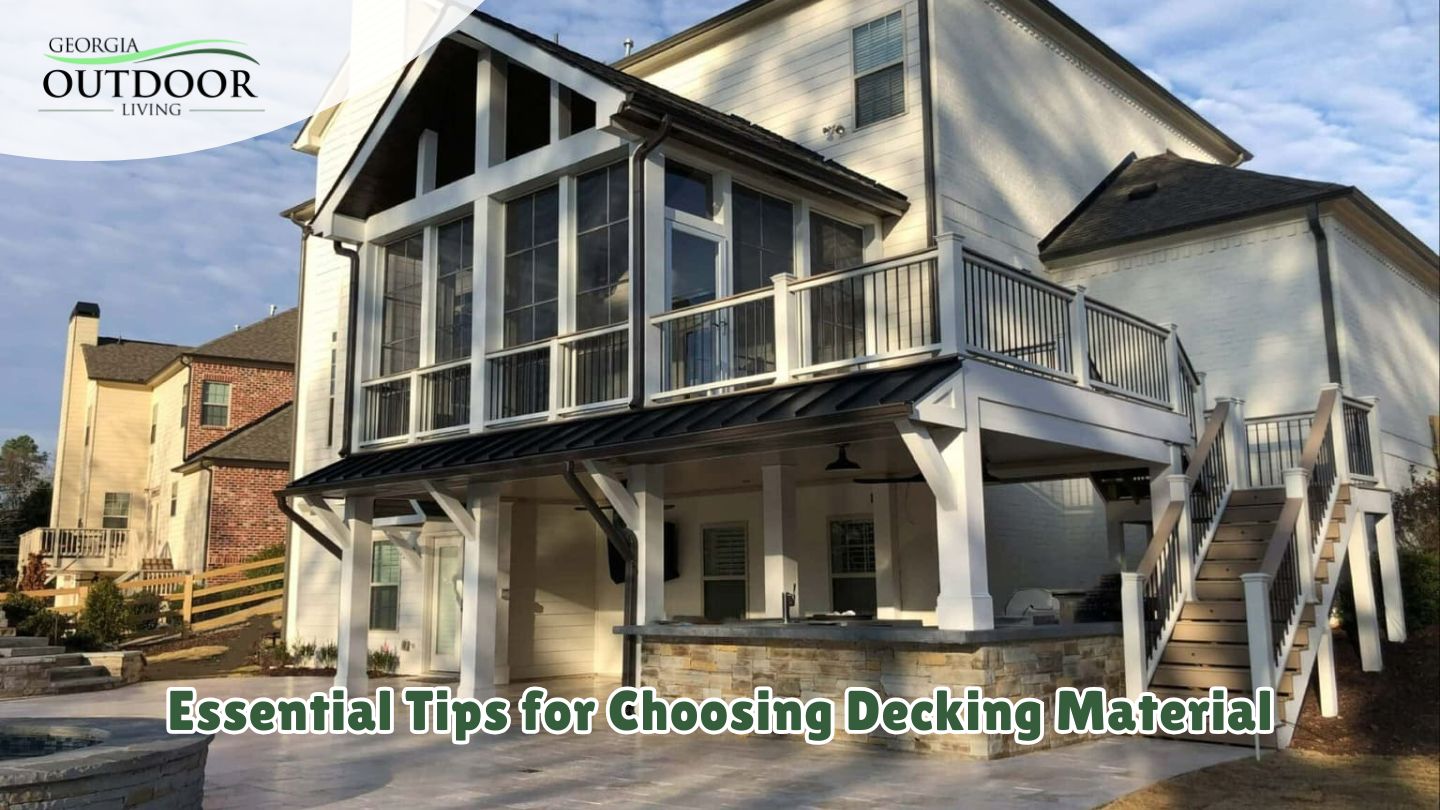Choosing the right deck material is a key decision for any outdoor project. Composite decking materials are a low-maintenance, high-performance option that blends recycled plastics and wood fibers. This guide breaks down options like wood, composite, PVC, and pressure-treated lumber, highlighting their benefits to help you make the best choice for your deck.
Key Takeaways
- When choosing deck materials, consider options like traditional wood, composite, and PVC, each with distinct benefits and upkeep demands.
- Maintenance needs and climate suitability are key factors to consider when selecting the right decking material for your outdoor space.
Understanding Decking Materials
Choosing the right decking material is crucial for a successful outdoor living space. With so many options available, it can be overwhelming to decide which material is best for your deck. Understanding the different types of decking materials and their characteristics can help you make an informed decision. Each decking material, whether it’s composite decking, wood decking, or PVC decking, comes with its own set of benefits and drawbacks. By familiarizing yourself with these options, you can select a material that aligns with your aesthetic preferences, budget, and maintenance capabilities.
Importance of Choosing the Right Decking Material
Choosing the right decking material is important for several reasons. Firstly, it affects the overall appearance and aesthetic of your deck. Different materials have unique textures, colors, and styles that can enhance or detract from your outdoor living space. For instance, composite decking materials offer a wide range of colors and patterns that mimic natural wood, while aluminum decking provides a sleek, modern look. Secondly, the right decking material can impact the durability and longevity of your deck. Some materials, like pressure-treated wood and composite decking, are more resistant to weathering, rot, and insect damage than others. Finally, the right decking material can also affect the maintenance requirements of your deck. Some materials, such as traditional wood decking, require more frequent cleaning, sealing, and replacement than low-maintenance options like PVC decking.
Evaluating Decking Materials

When it comes to choosing the right decking material for your outdoor living space, there are several factors to consider. Pressure-treated lumber is a commonly used and affordable option, often compared to composite materials and tropical hardwoods. The right decking material can make all the difference in the durability, maintenance, and overall aesthetic of your deck.
Factors to Consider
- Durability: How well will the decking material withstand the elements and heavy foot traffic? Durability is crucial for ensuring your deck remains in good condition over the years, especially in areas with harsh weather conditions.
- Budget: What is the upfront cost of the decking material, and are there any long-term cost savings? While some materials may have a higher initial cost, they could save you money in the long run due to lower maintenance requirements. For example, pressure-treated lumber is often more affordable upfront compared to composite options and tropical hardwoods, but it requires regular re-staining and care to extend its lifespan.
- Aesthetic: How will the decking material look and feel in your outdoor living space? The visual appeal of your deck is important, and different materials offer various colors, textures, and finishes to match your style.
- Sustainability: Is the decking material eco-friendly and sustainable? Choosing materials like composite decking made from recycled plastic and wood fibers can reduce your environmental footprint while providing a durable and attractive deck.
Composite Decking
Composite decks, made from a combination of wood fibers and recycled plastic, enhance durability and withstand harsh weather, making them a preferred choice. The advanced technology of modern composite decking materials closely mimics the look and feel of traditional wood. The longevity of these materials ensures sustained quality without the need for frequent upkeep or concerns about splitting or deterioration.
Composite decking is noted for being environmentally conscious, as numerous manufacturers incorporate up to 95% recycled content into their products. Contemporary options provide an array of hues and patterns that successfully replicate natural wood’s aesthetic appeal while maintaining eco-friendly attributes.
Capped Composite Decking
Capped composite decking is designed with a defensive layer that renders it impervious to water and ultraviolet deterioration, ensuring its longevity with barely any upkeep required. Composite decking materials with a capped layer require less cleaning compared to uncapped composites.
Another prominent benefit of capped composite decking lies in its aesthetic charm. It comes in an array of hues and textures that replicate wood’s appearance, allowing homeowners the opportunity to create a natural-looking deck without extensive maintenance. This melding of attractiveness and resilience establishes capped composite as one of the preeminent choices among various decking materials available today.
Uncapped Composite Decking
Composite decking materials offer a cost-effective choice for homeowners who are mindful of their spending, as uncapped varieties often come at a lower price point compared to capped ones. Nevertheless, this type of decking may be more susceptible to challenges such as fading and the growth of mold, potentially impacting its durability and aesthetic appeal over time.
Wood Decking

The allure of wood decking lies in its ageless charm, authentic appearance, and unique sensory characteristics like scent and sound, making it a favored option for homeowners looking to achieve an outdoor space with classic style. Deck boards made from traditional woods such as cedar, redwood, and pressure-treated pine offer distinct benefits that contribute to the visual appeal of a carefully kept wood deck. Pressure-treated lumber, while more affordable than cedar and redwood, requires regular re-staining and maintenance to extend its lifespan.
Nevertheless, maintaining wood decks is crucial to avoid deterioration concerns, which include rotting, splintering, and warping over time. Among these options, specialty woods like redwood and cedar stand out due to their superior resistance against the elements when compared to pressure-treated alternatives. They represent an ideal selection for individuals who prioritize investing in top-tier building materials.
Pressure-Treated Wood
Pressure-treated wood is a popular decking material option due to its affordability and durability. This type of wood is chemically treated to resist insects, rot, and decay, making it a practical choice for many homeowners. However, regular maintenance, such as sealing and staining, is required to prevent issues like mold and warping. Over time, pressure-treated wood can also crack and splinter, which may necessitate repairs or replacements. Despite these challenges, its cost-effectiveness and resilience make it a widely used option for decking.
Hardwoods and Premium Softwoods
Hardwoods and premium softwoods are known for their exceptional durability and resistance to rot, mold, and insect damage. Species like Ipe, Tigerwood, cedar, and redwood are popular choices for those seeking a high-end, natural wood deck. These materials offer a rich, authentic appearance that can enhance the beauty of any outdoor space. However, they come with a higher price tag compared to other decking materials. Additionally, to maintain their appearance and structural integrity, hardwoods and premium softwoods require regular maintenance, including cleaning, sealing, and occasional sanding.
Cedar Decking
Cedar decking is celebrated for its natural beauty and inherent resistance to decay and insect damage. Its rich color and fine grain create a warm, inviting outdoor space. Cedar is lightweight yet stable, making it easy to work with during installation. It naturally resists moisture, which helps prevent warping and splitting. However, to maintain its vibrant appearance and structural integrity, cedar decking requires regular maintenance, including cleaning and sealing. Despite these requirements, cedar remains a popular choice for those seeking a natural wood deck with a blend of aesthetics and durability.
PVC Decking
Renowned for its resilience to the effects of weather and requiring little upkeep, PVC decking stands as an option for homeowners who are pressed for time. It requires exceptional durability, which sets it apart from wood and composite alternatives since it demands virtually no maintenance. Available in hues such as brown, gray, white, and tan, along with patterns mimicking natural wood grain, this decking provides ample design flexibility.
Aluminum Decking
Aluminum decking offers the benefit of being both light and demanding very little upkeep, rendering it a fitting choice for diverse exterior environments. It boasts impressive resilience against moisture harm and pests, plus it retains less heat under sunlight, which results in a more pleasant walking surface. Reflecting on the advantages of aluminum decking can aid in reaching a well-considered conclusion. The aluminum decking pros include its resistance to water damage, rot, and insects, along with minimal maintenance requirements, lightweight construction, durability, and long lifespan.
Budgeting and Cost-Effectiveness

Budgeting and cost-effectiveness are important considerations when choosing a decking material. Different materials have varying price points, and some may be more cost-effective in the long run. While the initial cost is a significant factor, it’s also essential to consider the long-term expenses associated with maintenance and replacement. For example, while composite decking may have a higher upfront cost, its durability and low maintenance needs can result in cost savings over time. Similarly, aluminum decking, though initially expensive, offers longevity and minimal upkeep, making it a cost-effective choice for many homeowners.
Cost-Effective Decking Options
If you’re on a budget, here are some cost-effective decking options to consider:
- Pressure-treated wood: This is one of the most affordable decking materials available. However, regular maintenance is required to prevent splintering and warping. Despite the upkeep, its low initial cost makes it a popular choice for budget-conscious homeowners.
- Composite decking: While composite decking is more expensive upfront, it’s a cost-effective option in the long run. It requires minimal maintenance and can last for 25-50 years, making it a wise investment for those looking to reduce long-term costs.
- Aluminum decking: Aluminum decking is a cost-effective option for areas that are exposed to moisture, such as pools or lakes. It’s resistant to water damage and wood-boring insects, offering durability and minimal maintenance, which can save money over time.
By considering these factors and comparing the costs, you can choose a decking material that fits your budget while meeting your aesthetic and functional needs.
Final Tips for Choosing Decking Material

Here are some final tips to help you choose the best decking material for your home:
- Consider the environment: Choose a decking material that is eco-friendly and sustainable, such as composite decking made from recycled plastic and wood fibers. This not only helps the environment but also often results in a durable and low-maintenance product.
- Consider your local building codes: Check with your local building department to ensure that the decking material you choose meets local building codes and regulations. This can prevent potential issues during installation and ensure your deck is safe and compliant.
- Get professional advice: Consult with a professional contractor or builder to get advice on the best decking material for your specific needs and budget. Their expertise can provide valuable insights and help you make an informed decision that aligns with your vision and requirements.
- Long-term cost savings: While composite decking materials may have higher upfront costs, they offer long-term cost savings due to their durability and reduced maintenance needs. Pressure-treated lumber is an affordable option but requires regular maintenance, such as re-staining, to extend its lifespan.
By considering these factors and tips, you can confidently choose the best decking material for your home, ensuring a beautiful, durable, and functional outdoor space for years to come.
How Georgia Outdoor Living Can Help
At Georgia Outdoor Living, we understand the challenges of choosing the perfect decking material. As a top deck builder in Atlanta, we offer in-depth consultations to learn about your goals and help you explore options that align your outdoor space with your lifestyle. We are dedicated to ensuring each project matches your vision while maintaining our high installation standards. So, whether you are looking for a low-maintenance composite deck or a classic wood deck, our team has the expertise and resources to bring your dream outdoor space to life. Contact us today to schedule a consultation and start creating the backyard of your dreams.
Frequently Asked Questions
How long does it usually take to build a deck?
The timeline varies based on the project’s size and complexity, but most decks can be completed within a few weeks.
What materials are commonly used for deck construction?
A variety of high-quality materials are used, including wood, composite, and PVC, tailored to your preferences and budget. Composite decking materials are a high-performance option that blends recycled plastics and wood fibers, offering durability against weathering and reduced cleaning efforts.
Is it possible to customize the design of my deck?
Absolutely! A range of design options is available, and collaboration ensures a deck that meets your specific needs and style.



